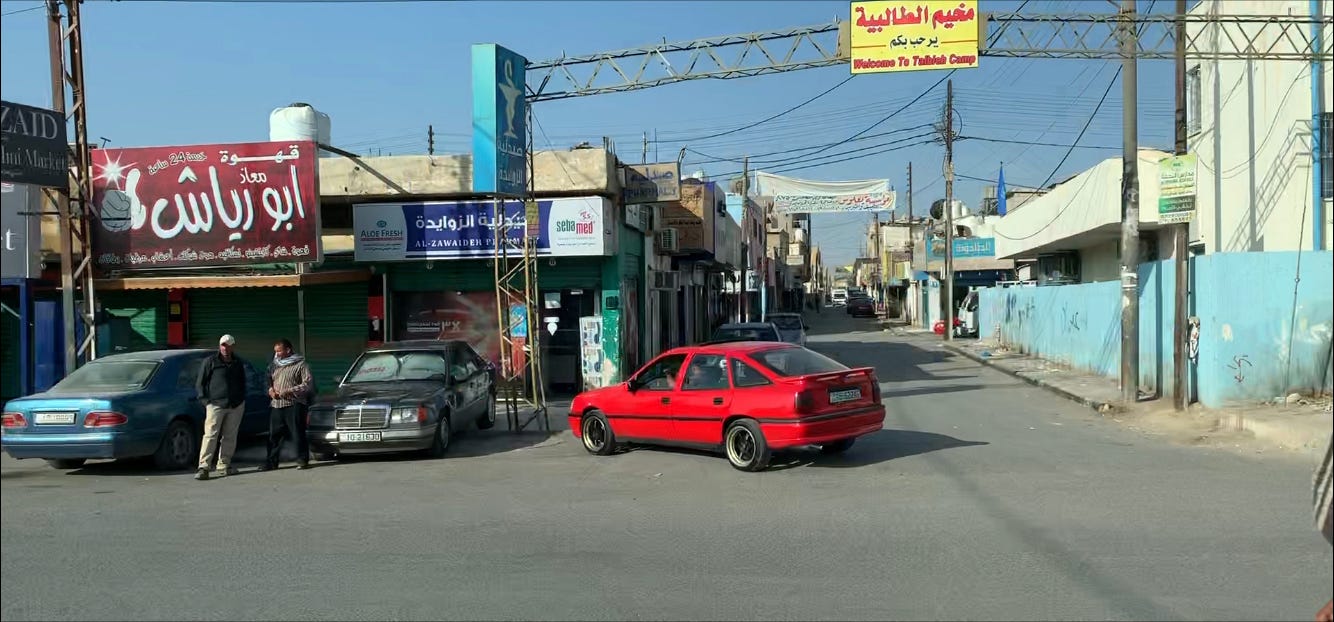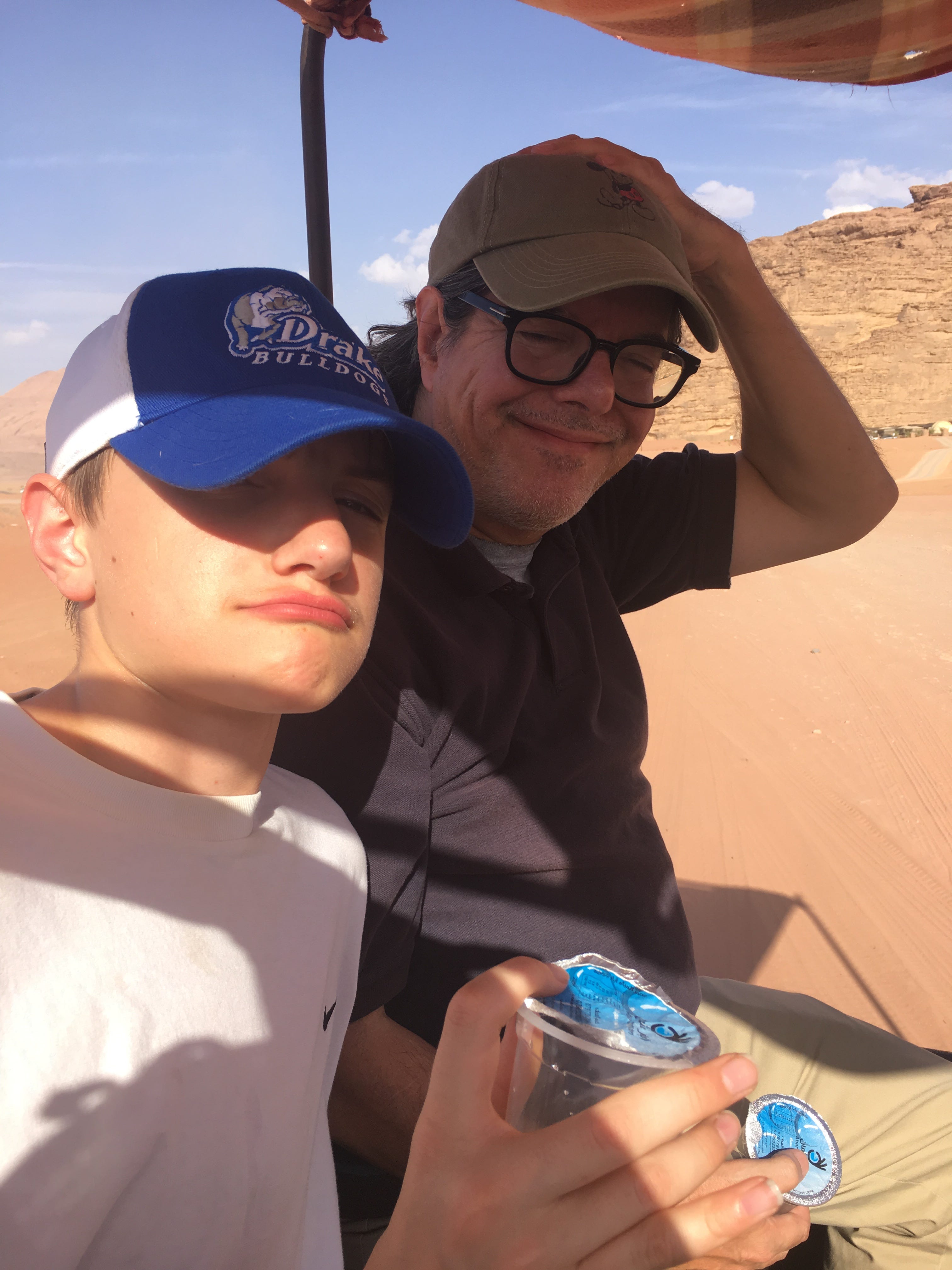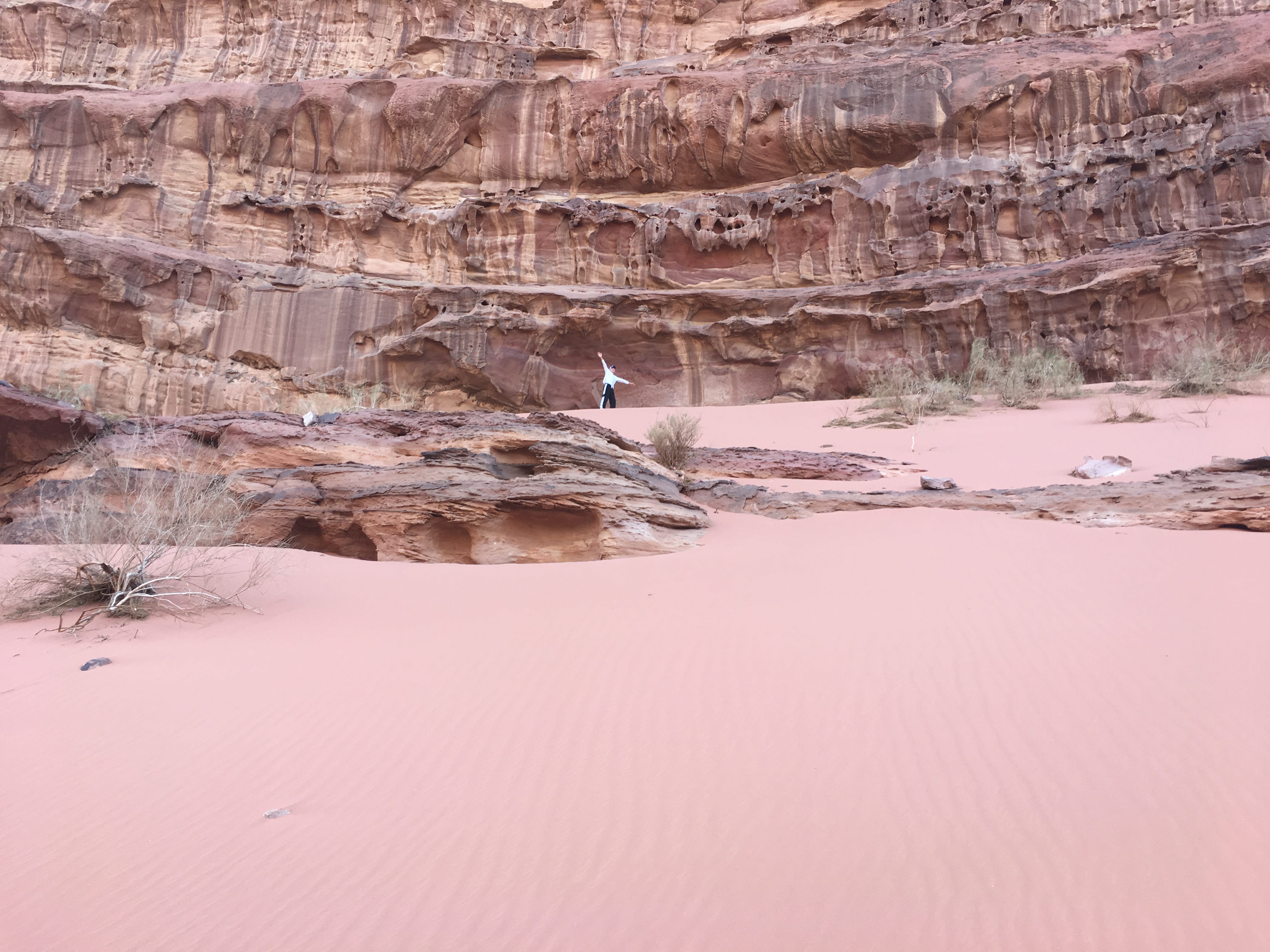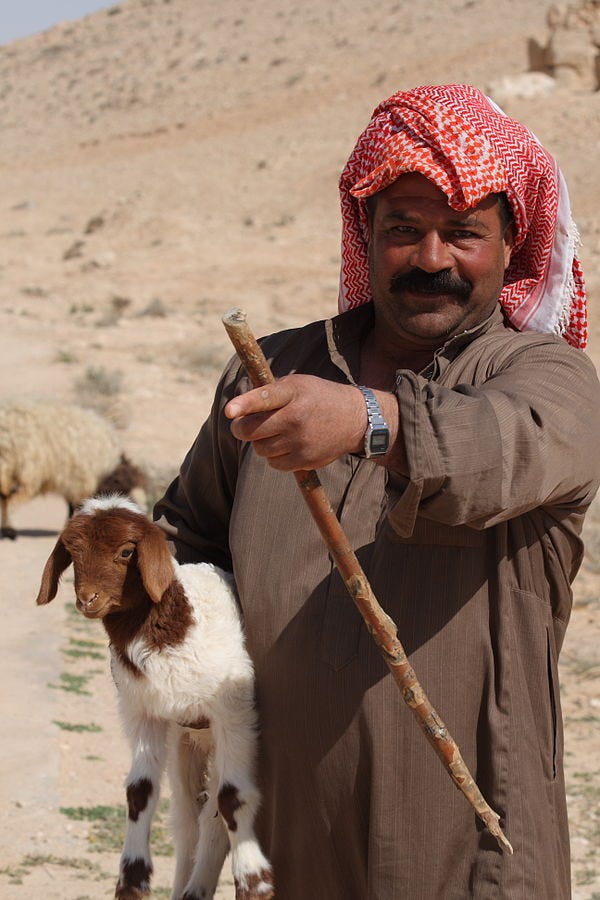By Kent R. Kroeger (NuQum.com, November 16, 2019)
________________________________________________________________
This essay documents my challenges and observations during my family’s recent travels through Oman and Jordan.
This is the second essay in a series. The first essay can be found here.
________________________________________________________________
Our Jordanian guide, Abo, a middle-aged man of Palestinian descent, greeted us outside our hotel in central Amman.
“Good morning!” he said with a wide grin across his handsome, sun-weathered face. “We have a long drive to Wadi Rum.” A five-hour drive, according to Siri.
As my wife, two of her work colleagues, and my son piled into a white Dodge Caravan, I hurriedly finished a Boston creme I purchased from a Dunkin Donuts next to the hotel. My wife glared back at me, knowing I would mess Abo’s nicely detailed van if I tried to finish my feeble breakfast there.
“I’m sorry, Christa. I was hungry.” Her glare softened somewhat.
“Just finish it outside.”
My teenage son, Zach, in a constant grump since arriving in Amman, especially after our room’s satellite TV feed went dark, jumped into the far back rumble seat with me and put in his earbuds, immediately losing himself in a YouTube video.
Abo gave us a quick description of the route we’d be taking through Amman’s southern suburbs and then south on Jordan’s Route 15.
“Can we stop at a QuikTrip?” Zach barked up to his mother, sounding like a military officer’s command to an XO. Abo, thinking the question was for him, seemed puzzled.
“I don’t think they call them QuikTrip’s here,” I told Zach.
“A 7–Eleven?” Zach clarified, as if that would help Abo understand. “WaWa?” was Zach’s last halfhearted attempt at generating mutual understanding, as his attention returned to his video.
This was going to be a long ride.
_________________________________________________________________
I pulled out my cell phone to plot our trip on Google Earth and wasn’t encouraged when the virtual terrain looked like a mix of Utah’s Salt Flats and Nevada’s Mojave Desert, with a few small villages sprinkled here and there.
I tried to ask Abo about any sights of interest along the drive, but the combination of road noise and my wife’s shoptalk with her colleagues left my question unheard and unanswered.
Perhaps I’ll grab some additional sleep, I thought to myself, but then remembered my wife was in the van. There would be no sleeping.
Among my wife’s best qualities is her limitless curiosity, as she will ask questions and pester hosts right up to their breaking point — and everyone has a breaking point (except for Abo, thankfully).
We were on the road for no more than an hour when we came to an isolated, but sizable town.
“What city is this?” Christa asked.
“Talbieh Camp,” replied Abo. “A Palestinian camp created after the 1967 War.”
Consisting mostly of internally displaced Palestinian Jordanians when it opened, as opposed to Palestinian refugees that crossed into Jordan during the war, the camp today is home to about 9,000 Palestinians living in an area covering roughly 0.13 square kilometers — about three times the population density of Guttenberg, New Jersey (the most densely-populated incorporated municipality in the U.S.).

As we passed the camp, Abo related his own story in which, as a young boy, he was forced to move with his family from Jerusalem to Jordan as a consequence of the ’67 War.
“My family still has a home and property in Israel,” said Abo. “We could sell it, but the Israelis will only let us sell it to the them.”
My follow-up question about whether the property is earning income for his family went unheard as my wife asked why many of the homes in Talbieh had concrete columns with rebar protruding from the top of the dwellings. It was a better question anyway, as it was striking how many homes and buildings in these camps had an unfinished look.
“So they can add a new floor,” replied Abo.

“Say again?” asked Christa.
Abo explained how the Jordanian government limits the number of floors a home can have, but, under current law, the government won’t make a family tear it down if the additional floor is complete. So, when a family can afford it, the family hires building contractors to come in at night and complete the new floor before morning.
Whether Abo’s story is a complete explanation is less important than the symbolism of these concrete columns. “Necessary incompleteness” is how writer and filmmaker Joseph Redwood-Martinez characterizes this architectural phenomena, which exists in other parts of the world as well, such as Haiti, the Dominican Republic, Ecuador, Mexico, the United States, Jordan, Israel, Palestine and Turkey.
Redwood-Martinez quotes a Palestinian artist in Ramallah (West Bank) as saying the concrete columns represent Palestinians’ “optimism for the future.”
Optimism is a word not often associated with the Palestinians in the Western media. But I heard it many times while in Jordan. Abo’s own story is an exemplar of this outlook. A refugee of the Israeli-Palestinian conflict as a child, as an adult he helped build a successful Jordanian tourism company and, today, his children are college-educated or bound, including a son studying at a U.S. university. Abo and his family’s story is not uncommon in Jordan.
Just over 2.5 percent of Jordan’s total population is enrolled at a university, a proportion comparable to the United Kingdom, and the percentage of Jordanians 25 years old and older with at least a college degree has risen from 9 percent in 2001 to 12 percent in 2014, according to the World Values Survey. In comparison, 36 percent of U.S. adults in this age bracket have at least a college degree.
_________________________________________________________________
Abo spoke with obvious pride about his family, particularly with respect to their educational accomplishments, and about Jordan, in general. But his contagious enthusiasm was also laced with a keen understanding of the country’s realities.
Jordan has a lot of refugees, he would remind us as we drove past smaller, more recently opened refugee camps, usually Syrian’s that had fled the Syrian Civil War.
Jordan hosts over 670,000 Syrian refugees, but has not permitted these refugees to seek asylum, according to Human Rights Watch. The Syrian refugees tend to be isolated in remote border areas within Jordan with limited access to humanitarian aid.
In addition to the existing refugees who are fully or partially integrated into Jordanian society, the Syrian refugees will further increase the financial commitment required by the Jordanian government and the international community to handle Jordan’s refugee population.
And the Jordanian education system is already under pressure.
The recent influx of Syrian refugees (in addition to a large number of existing refugees from the West Bank, Gaza, Iraq, Egypt and other parts of the Middle East) have put tremendous pressure on the capacity of Jordan to handle more students. Adding to the stress, the unilateral decision by the U.S. in August 2018 to stop its contribution to the United Nations Relief and Works Agency (UNRWA), which in amounted to about one-third of the Agency’s $1.1 billion 2017 budget, has had a devastating impact on Palestinian refugees in Jordan, particularly children.
UNRWA services to the 2.3 million Palestinian refugees registered in Jordan include aid for education, health care, food security and other essential day-to-day services. UNWRA also employs thousands of Jordanians.
“These funds go toward a modern, secular education for 500,000 boys and girls; vaccinations and health clinics that provide services to over three million refugees and a basic level of dignity for millions who otherwise would lead lives of despair,” said Hady Amr, a Nonresident Senior Fellow at the Brooking Institute’s Center for Middle East Policy, soon after the U.S. decision was announced. “So when UNRWA cuts back services in the impoverished refugee camps in Lebanon, Jordan, Syria, the West Bank, and Gaza, what forces on the ground will fill the void? Whoever it is, they are unlikely to be America’s friends. Even the Israeli military knows that cutting funding for basic services to refugees are a recipe for disaster for Israel.”
While not necessarily linked to the U.S. action against UNWRA, a November 5th knife attack on tourists in Jerash, Jordan by a young, unemployed Palestinian refugee from the UNWRA-run Jerash Camp highlights a subgroup in Jordan susceptible to radicalization and to committing acts of violence.
According to the assailant’s family, the young man grew more radicalized after being unable to attend a higher education institution due to its cost and, subsequently, finding it difficult to find regular employment.
That is a story that may become even more common in Jordan if it cannot adequately support the growing demand for educational and other social services among its most economically vulnerable populations.
_________________________________________________________________

We eventually made it to Wadi Rum, one of God’s geologic masterworks in southern Jordan, where a number of well-known American movies have been filmed, including David Lean’s Lawrence of Arabia and, more recently, The Martian, starring Matt Damon.
Wadi Rum’s wind-eroded, sun-drenched sandstone and granite rock formations are beautiful and humbling.

Among the region’s many striking geologic features are The Seven Pillars, which was the inspiration for the title of T. E. Lawrence’s autobiography, The Seven Pillars of Wisdom, an account of his experiences during the Arab Revolt of 1916–18, when Lawrence was based in Wadi Rum as a member of the British Forces of North Africa.
Lawrence grew to respect the harshness of the desert environment surrounding and encompassing Wadi Rum, also known as the Valley of the Moon. “By day the hot sun fermented us; and we were dizzied by the beating wind. At night we were stained by dew, and shamed into pettiness by the innumerable silences of stars,” he wrote.

All the same, from the vantage point of a sporty all-terrain vehicle, Wadi Rum seemed quite hospitable to the human desire for play, almost calling out to have you run up one of its limitless number of sand dunes or scramble to the top of one of its towering, craggy rock faces.
We learned quickly, however. Don’t do that.
While its sad to think mass tourism might someday harm the natural beauty of Wadi Rum, the region has many assets working in its favor to mitigate that problem. For one, its relentless, sand-saturated winds can wipe out evidence of human activity in just minutes. Furthermore, if its hair-roasting, bone-dry heat doesn’t convince you of its hostility towards humans, a presumptuous dash up one of its sand dunes will more than break whatever remaining spirit you still possess.
“Try running up this sand dune,” challenged Abo, as he stopped the ATV in the midst of a relatively narrow passage bordered by two parallel rock formations, each about 200 feet in height with walls of sand drifting up perhaps 20 to 30 feet at their base.
“How hard can this be?” I shouted towards Zach, who was 10 feet up the sand drift before he had a chance reply.

How hard could it be? Really? Zach was already a few feet from the top, talking smack back in my direction.
“Dad, you’re too fat,” was his encouragement.
It did seem like Zach’s 90-pound frame coasted up the drift; where as, my 185-pound heft seemed to get increasingly swallowed by the sand with every step. And when the sand wasn’t chewing me up, it was pushing me back down the dune.
What took Zach maybe five minutes to accomplish, I needed 20, taking a brief respite at the three-quarter mark, a demarcation I dubbed the ‘death zone,’ seriously wondering if my heart might stop if I took one more step. Combined with the energy-sapping heat, I genuinely entertained the possibility I could die right there, on a nameless sand dune in a place that was beginning to look more like Mars than Earth. The warning that someone lost in this desert on an especially hot day could die within hours was becoming palpable.
A month removed from my attempt to scale what was. objectively, a small sand dune, my back still hasn’t forgiven me and I’m still digging sand out of my fingernails.
Wadi Rum’s natural environment is beautiful but not made with humans in mind. It’s uncharitable ecosystem makes it even more remarkable that a group of people like the Bedouins — a nomadic people that live in the desert — have survived off this land since the time of the Old Testament. Jordan alone has 360,000 Bedouins living within its borders, more than any other country except Syria and Saudi Arabia.

Where Westerners prefer occupying and terraforming hostile environments to fit their wants, the Bedouin’s have, out of necessity, adapted to the challenges of the Arabian desert. And, to a similar extent, the Arabs throughout this region share this accommodative trait with the Bedouins. The Arabic term Naseeb — meaning fate or destiny — is part of the cultural bedrock for Muslims, reinforcing their deference to Allah’s will. In American colloquial language, we’d say the Jordanians and the Bedouins know how to go with the flow.
Has this traditional, almost fatalistic attitude held back economic development and social progress in the Middle East? I’m skeptical, though Western social scientists love using culture-based, Clash of Civilizations-type theories to explain variation in economic and social development across world cultures.
But as I laid on the side of that sand dune in Wadi Rum wondering how long it would take for the wind to completely cover my lifeless body in sand, the last thing on my mind was whether cultural norms centered on self-expression and secular-rational values are best at promoting economic and social development.
I just wanted to get off that sand dune and to our lodging for the night — a tent. A very nice, air-conditioned “tent”…with satellite TV.

_______________________________________________________________
